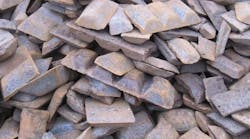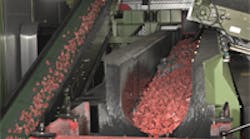Visiocorp Deutschland Gmb H ( formerly Schefenacker Mirrors GmbH) is one of the world’s largest manufacturers of automotive rearview mirrors, as well as the component parts of the same. The plant near Stuttgart, Germany, produces diecast aluminum components for mirror assembles, for numerous automotive plants worldwide. Christian Barth, who manages Visiocorp’s metalcasting department explains: “To maintain our competitiveness at our German location we had to implement fully automatic manufacturing technologies.”
Finished diecastings may be painted or used as-is, but in either case the surfaces must be entirely free of flashing or metallic imperfections, as well as process oil. More than 100 different types of parts — weighing 1.5 ounces up to 5.5 lb — must be handled in the same cleaning and finishing process.
“The streamlining of the finishing process, the increase of productivity, a high system uptime in our 18-shift operation, top equipment quality and its adaptability to our special operating conditions were all very important,“ Barth details.
Based on these criteria a Rösler R 550/4600 linear continuous vibratory system (www.rosler.com) was integrated into the diecasting production process. To minimize the noise level for workers at nearby production centers, the entire system was installed in a “sound-enclosing cabin” to keep noise levels at <78 dB(A).
The fragile diecastings are transported to the vibratory finishing system from the floor below via a special installed “elevator,“ which simplifies material handling and minimizes personnel requirements. A PLC with 20 different processing programs makes it possible to achieve the optimum surface finishing on each of the different parts. The same elevator that transports one bin full of parts at a time to the second-floor finishing line, lifts/rotates it by 180°. A retaining gate prevents parts from falling out of the bin prematurely, and damaging the diecastings’ surface finishes. Once the bin has reached its unload position, this gate is removed and the parts slide onto the vibratory buffer conveyor.
Once they’re dried, finished parts are transferred to a buffer belt with two, two-directional tracks, so that each diecasting can be entirely visually inspected. Then, according to the weight of the diecastings in production, the parts transfer from the vibratory hopper into the finishing machine. Visiocorp’s current production volume totals about 650 parts each 20 minutes.
A second vibratory conveyor separates the parts from each other, and transfers them to a conveyor belt which, in turn, transports them into the finishing machine. This load system was necessary because parts tend to become entangled. The finishing machine, with a channel that’s 21.5 in. wide and 15 ft. long, allows a gentle deburring and de-greasing that produces a homogeneous surface finish.
The finishing media are 1.5-in. (40-mm), polyester pyramids. A powerful, variable-speed drive and a work bowl that floats on four adjustable air cushions allow variable processing times.
Separating finished parts from media takes place in an independent vibratory screening machine with two integrated steps. The screening unit minimizes drop heights to prevent part-on-part collisions of the delicate components. After separation, finished parts are conveyed through a hot-air belt dryer from and then transferred to a buffer belt with a pair of twodirectional tracks.
In the final step, each finished part is visually inspected, completing a very productive and repeatable process. “The high productivity was mainly achieved by the automatic loading system,” Barth details. “This allows us to run the machine with 1.5 people. We would not have achieved this with any other system available.”









